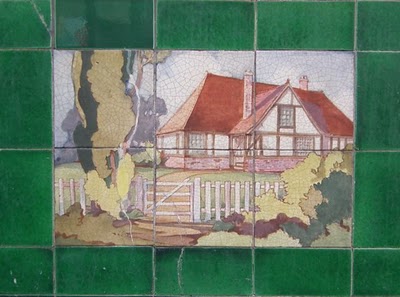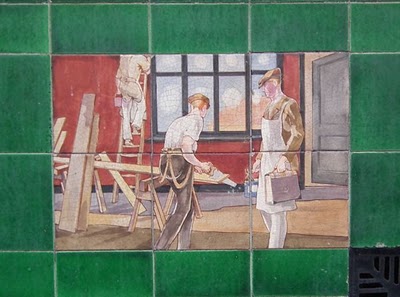Philip Wilkinson is the author of over 40 books, including The English Buildings Book, and most recently The High Street, written in conjunction with the BBC TV series. Happily for us, he’s also the curator of the English Buildings Blog, a firm favorite here at The Dabbler. In this new series of posts, Philip talks us through some overlooked architectural gems…
The Victorians and Edwardians having led the way in the use of tiles in retail design, the designers of the interwar years and the mid century followed. They saw the potential of tiles both for patterns and for one-off pictorial designs that could act as vivid advertisements of the shopkeeper’s wares.
This approach could work well if the shopkeeper found it hard to come up with attractive window displays. Unless you’re the most obsessive devotee of decorating tools and materials, for example, pots of paint and brushes don’t look that inspiring in a shop window. It’s what you do with them that is interesting. So the former premises of Frederick E Gillett, supplier of paints, brushes, and allied goods on London’s Vauxhall Bridge Road, use tiles to tell the story.
The shop is decorated with two evocative tile panels, set below the window at shin level, but in a position to catch the eye as one hurries along the pavement towards Victoria Station and home. One of the panels depicts a timber-framed bungalow that looks a world away from inner London and the other shows some workmen – a carpenter, a decorator ascending a ladder with a paint kettle, and a man carrying what looks like a wallpaper sample book. Hans van Lemmen and Chris Blanchett in their book 20th Century Tiles think that the tiles may have been the work of a company called Dunsmore, a small firm based in Campden Hill, Kensington that started in business around 1927.
These tiles embody simple messages of a rural lifestyle and a job carefully done. I especially like the interior with its telling touches – the downward glance of the standing man as he appraises the carpenter’s saw cut; the latter’s dangling braces; the handmade wooden ladder.
For the passer-by or customer, the panels suggested an entrée into another world, far away from Victoria or Pimlico. It’s a place where art and craft – the careful application of paint and the skilled practice of carpentry – can help you create a home to be proud of, a place perhaps to escape to, a place, if not in the country then in Bromley perhaps or Metroland, where the countryside is not far away but from which town can be reached with ease by train or underground.
Those who passed by this shop in its heyday would have recognised this world quickly enough. It was all over advertisements in the newspapers; specialist magazines like Architectural Review, which were full of ads for paint and building materials, depicted it too. The reality might not be quite so sylvan or countrified as the image. But the idea was there, ready to transport us with a pot of paint beyond the speeding trains and crawling omnibuses of Victoria to a another quieter place.













I walk past these tiles regularly, they do brighten up what is an otherwise grey street. There is a terrific old bank building opposite that is now a Fullers pub called the Jugged Hare
Finding a pre B&Q or Homebase home improvement emporium requires the services of a private dick, they do exist however in the Scottish Borders, an area that time mislaid. No tiles unfortunately, just the eccentric owner muttering about B&Q and Homebase, sitting in fingerless gloves at the partners desk totting up the ledger. To…£, From…£, normally in pre decimalisation sterling, nails can still be purchased by the pound, weighed out on ancient scales and wrapped in a brown paper bag.
There still exists in the Northumbrian market town of Morpeth a dinosaur, Smailes, tiles below the window although somewhat flood damaged now. Until comparatively recently the proprietor, now sadly gone to the great fork handle in the sky, was truly magnificently batty old burd, Miss Smailes, ancient, unmarried, splendid mustache, Paisley pinafore, wet look wellies and unsmiling. The staff, all splendidly kitted out in brown warehouse coats would rush around like blue arsed flies serving the customers who always had to “go and see Miss Smailes” with the purchases, who sitting at a raised desk in the middle of the floor then priced the stuff, took the money, no plastic, just cash which was dropped into a leather bag, a quick scowl then “next”. She was undoubtedly Morpeth’s answer to Bleak house’s Mr Tulkinghorn.
I once heard her say to a customer who inquired about paraffin “yes, we keep it loose”
Malty, just wondering if you or Frau M. have ever had cause to enter The Sewing Box in Newgate Street, Morpeth — a bizarrely old-fashioned emporium of all things dressmaking and needlecraft? It’s a warren of tiny cave-like rooms distributed over several floors, each piled high with fabrics, trimmings, sewing supplies, and miscellaneous haberdashery, including some of the most exquisite (and expensive) buttons you’ll ever feel the need to fiddle with. Nothing self-consciously retro about it, but stepping in there has a queer feeling of time travel, like falling into some giant dressing-up box from a Victorian nursery …
These unobtrusive little gems deserve to be immortalised – and I suppose they now are, thanks to Philip and the internet.
Isn’t it inspiring that an independent shop should commission original – and lasting – artworks, such as these?
Malty: I like the sound of Miss Smailes and her loose paraffin. I used to go often into the premises of another fork handler, the ironmonger in Endell Street, Covent Garden. I once aksed for a sickle in there to be told that they had no sickles, only a ‘short-andled baggin ook’. I took the hook, having been assured that the large size was the better of the two on offer: ‘That’s a man’s ook, that is’. No tiles though…
For what task did you have need of a sickle in your capacity as a freelance writer, I wonder?
Ah Brit, it was in a previous life as an editor. I needed it for a photo shoot.
And there you were, thinking I was toiling the green fields of Covent Garden.
I was pondering a more occult, possibly druidical use Philip.
Sacrifical goats were definitely featuring in my imaginings…
My vote goes to Malty for this month’s comment. I hope Gillett’s is protected from demolition et cetera. It’s such a nice sight as you go down that rather dismal road.